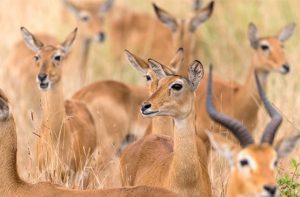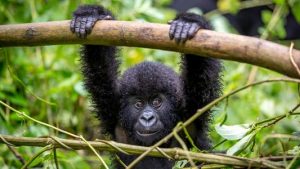Day 1: On arrival, you will be welcomed by your bird guide on the safari, he/she will be holding a placard with your name written on it. You will be transferred to your hotel where you will be debriefed, rest and relax.
Day 2: After your early morning breakfast, you will be transferred to Kisoro – south western Uganda, we will have a stop in Echuya forest for a brief birding experience.
Day 3: Birding Mgahinga National Park
We will have an early start today and with picnic lunch set off through a variety of montane habitats for our most sought after birds today like the Dusky Turtle Dove, Rwenzori Turaco, Cape Robin-Chat, Kivu Ground Thrush, White-eyed Slaty and White Tailed Blue Flycatcher, Olive Wood-pecker among others.
Day 4: Birding in Ruhija
Our birding today will start in the rift valley area and a near by swamp, we will mostly be looking for the Little Rush Warbler plus the Grauer’s Rush Warbler one of the rare Bradypterus Warblers within the Albertine rift zones among others.
Day 5: Birding in Mubwindi Swamp
With an early start, we will go in search of species like the beautiful leafy looking broadbill, Black-billed Turaco, Olive, Elliot’s and Fine-banded Woodpecker, African Hill Babbler, Mountain Illadopsis, Yellow-eyed Black Flycatcher, Mountain Greenbul, Grey Cuckoo Shrike among other birds.
Day 6: Birding in Buhoma
Today we will drive to the southern part of Bwindi impenetrable national park, with multiple stopovers expect to see birds like the Black Bee-eater, calling out the Red-throated Wryneck and finding it would be a great addition, Mountain Wagtail and the Cassin’s Grey Flycatcher, White-starred Robin, Olive Thrush, Red-faced Woodland Warbler, Grauer’s Warbler, MacKinnon’s Fiscal, Collared, Mountain Masked Chestnut-throated, among others.
Day 7: Birding in Bwindi Impenetrable National Park
In our birding exploration today, we will be looking for birds like the Pink-footed Puffbuck, Yellow Billed Barbet, Bocage’s Bush-Shrike, Bar-tailed Trogon, Black Bee-Eater, Cassin’s and Scaly throated Honey Guide, White-headed Wood-hoopoe, Western Green Tinkerbird, Short Tailed Warbler, African Broadbill, among others.
Day 8: Birding to Kasese
With packed lunch, we shall leave for Rwenzori National Park. While there we look out for special birds like the purple breasted sunbird, Abyssinian, Red faced, Shelly’s and Dusky Crimson-wing, Red-bellied seed cracker, Woodhouse Antipecker, Stripe-breasted Tit, Forest Flycatcher, Grey Apalis, Ayres and Cassin’s Hawk-eagle and many others. We stay at the basement of Mount Rwenzori.
Day 9: Rwenzori – Fort Portal
We have another day of birding in the morning before we transfer to Fort Portal where a number of rare and highly localized birds may be found. African Long-eared Owl, sometimes considered nonspecific with the Holarctic Long-eared Owl. This is one of only two sites in East Africa [the other being Mt. Kenya] where this bird has been recorded. Similarly the Greater Double-collared Sunbird [sometimes considered a separate species, Stuhlmann’s Double-collared Sunbird] is endemic to the Rwenzori Mountains and is reportedly fairly common in areas of bamboo and heath. Rwenzori Turaco another common and easily seen here than elsewhere. There are recent sight records of the rare Grauer’s Cuckoo-shrike we keep fingers crossed for these amazing species.
Day 10: Birding in Semliki National Park
After an early breakfast, we will drive to Semuliki National Park getting there in time to bird the trails around the hot springs. This gives us a great introduction to the Semliki birds like the Hornbills, Chestnut Breasted Negro Finch, Black Bellied Seed Cracker and others then transfer to Bundibugyo.
Day 11: Whole day birding in Semliki National Park
After breakfast, proceed for a whole day birding on the Kirumia trail. Depending on the weather condition today we have some of the best birding within the East African region as many species are of West and Central African Origin. Look out for birds like Black-casqued wattled, White thighed, Piping, Red-billed dwarf, White crested and Black dwarf Hornbill, Rufaous Sided Broadbill, Blue Billed and Crested Malimbe, Blue-headed Crested-flycatcher, Leaf Love, Swamp palm Bulbul, rarely seen are the Capuchin Babbler and African Piculet small bird of its own related to the woodpeckers and the Lyre Tailed Honey Guides among other birds.
Day 12: Transfer to Entebbe
On your long drive to Entebbe, we will bird our way as we end our 12 days Albertine Rift endemics



